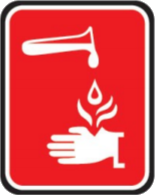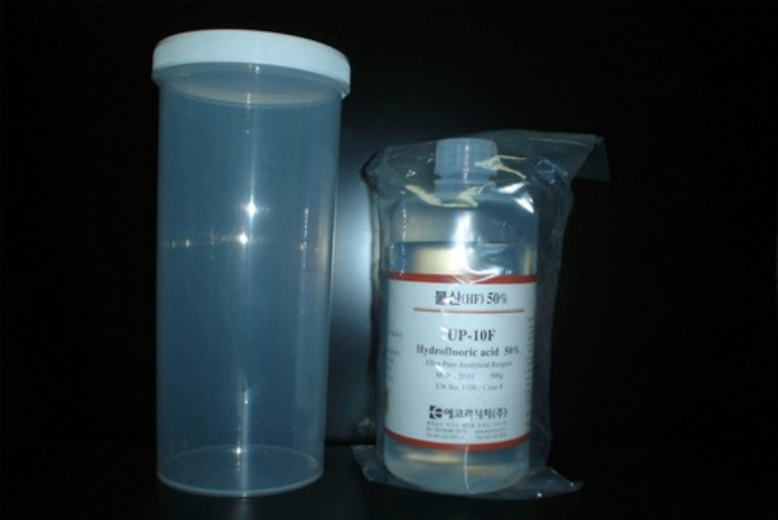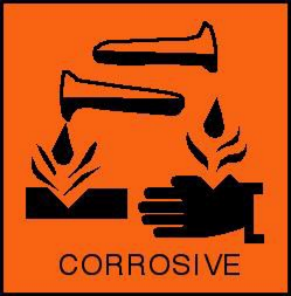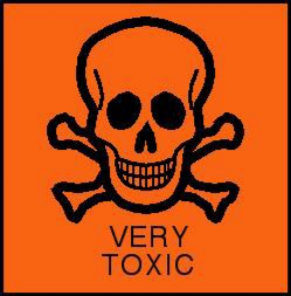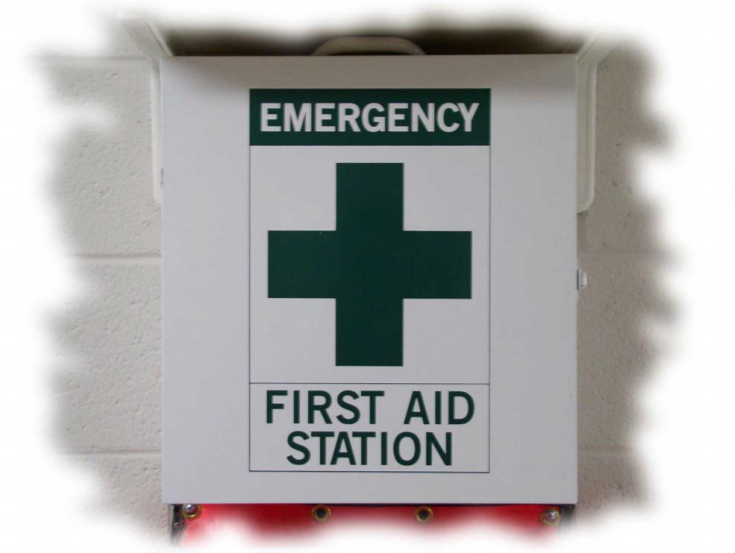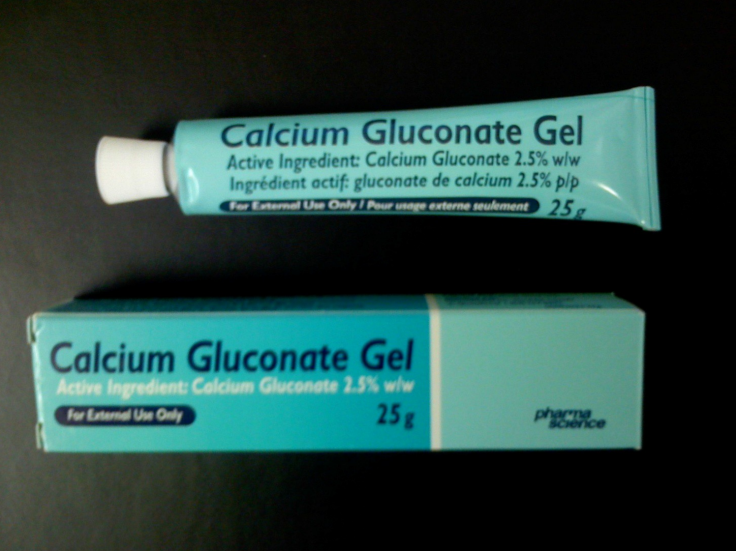Standard Operating Procedure: Hydrofluoric Acid
Hydrofluoric Acid (HF)

Hydrofluoric Acid
Hazardous Liquid
Causes SEVERE BURNS, which MAY NOT be immediately painful or VISIBLE.
AVOID CONTACT WITH EYES, SKIN AND CLOTHING!!
Use 2.5% Calcium Gluconate Gel IMMEDIATELY on burn TO REDUCE SKIN and BONE DAMAGE.
Purpose of Training
The Purpose of this training session is to develop safe working, handling and emergency procedures for the laboratory personnel when working with concentrated hydrofluoric acid (HF).
Hydrofluoric Acid Overview
- Hydrofluoric acid is a clear, colorless liquid.
- It is an extremely dangerous material and all forms, including vapors and solutions.
- HF can cause severe, slow‐healing burns to tissue.
- Reaction to contact may be delayed. At solutions of 20%, burns may not become noticeable for hours.
- HF readily penetrates skin, damaging underlying tissue.
- The fluoride ion can then cause destruction of soft tissues and decalcification of the bones.
- HF can cause severe burns to the eyes, which may lead to permanent damage and blindness.
- Even for minor or even suspected contact, seek immediate medical attention.
Hydrofluoric Acid Storage
- Concentrated HF should be stored in an acid cabinet in a secondary containment container. Secondary containment container should be constructed of polyethylene (i.e. plastic).
- Do not store HF with incompatible materials such as glass, ceramics, and metals. Reactions with metals may generate potentially explosive hydrogen gas.
- All cabinets containing concentrated HF should be clearly marked and have a copy of the SDS posted prominently
- Due to the hazardous nature of the material only minimal quantities of material should be purchased and stored. Quantities will be determined on a case by case basis by the University Chemical Management Center.
Hydrofluoric Acid Handling
- All operations involving concentrated HF will be performed in a fully functioning chemical fume hood.
- The laboratory worker must use all personal protective equipment (particularly gloves and eye ware) specified by the SDS sheet. Contact the Chemical Management Center for more glove information.
- No work with concentrated HF will be performed alone. A second person cognizant of the dangers and emergency procedures for handling HF contact must be present at all times within the laboratory while the operations with concentrated HF are being carried out.
Hydrofluoric Acid PPE
The following are just general guidelines. The SDS is the primary authority on what PPE to use.
- Ventilation: Concentrations greater than 5% must be used within a fully functioning chemical fume hood.
- Eye Ware: Chemical splash goggles and full face shield must be worn. Safety glasses with eye shield do not offer adequate protection.
- Body Protection: Lab Coat with chemical splash apron made from natural rubber, neoprene or viton. Never wear shorts or open toed shoes in the lab.
- Gloves: Medium or heavyweight viton, nitrile, or natural rubber gloves are worn when working with HF. A second pair of nitrile exam gloves are worn underneath for protection against leaks. If gloves are contaminated, quickly remove them and thoroughly wash your hands and check for signs of contamination.
- PPE not contaminated with HF may be disposed of in common trash. If contaminated with HF, dispose of as HF waste.
Hydrofluoric Acid First Aid
Prevention of Exposure
Prevention to Exposure must be the primary goal.
- Make sure anyone handling HF is aware of properties and dangers.
- Train everyone who uses HF in proper handling and safety precautions.
- Utilize all appropriate engineering controls, making sure they are maintained and functioning properly.
- Require everyone who uses HF to have available proper safety and personal protective equipment.
- Arrange ahead of time to provide first aid or medical treatment if necessary.
First Aid Requirements
- All labs having concentrated HF must have the following:
- For skin contact a tube of 2.5% calcium gluconate gel present within the laboratory.
- For eye contact a sterile solution of 1% calcium gluconate or dropper bottle of 0.5 % pontocaine hydrochloride (Also Known as Tetracaine, Opticaine, Cepacol Viractin, & AK‐T‐Caine PF).
- All laboratory personnel working in the area must be informed of the special hazards involving the use of concentrated HF and know where the calcium gluconate gel is located.
- Calcium gluconate may be purchased through:
Calcium Gluconate Gel (CALGONATE)
Emergency Procedures
Skin Contact
In case of skin contact with concentrated HF:
- Wash the affected area immediately under running water either under the safety shower or some other source and flush affected area thoroughly with cool running water for at least 5 minutes before applying calcium gluconate gel. Remove all contaminated clothing while flushing. Speed and thoroughness of washing off the acid is of primary importance
- Apply a generous amount of calcium gluconate gel to the affected area. Massage the 2.5% calcium gluconate gel into the burn site. Apply every 15 minutes and massage continuously until pain and/or redness disappear or until more definitive medical care is given. It is advisable for the applier to wear protective gloves.
- If calcium gluconate is not available, rinsing must continue until medical treatment is rendered.
- Seek immediate medical attention at a hospital. Continue calcium gluconate massaging while in transit.
Eye Contact
In case of eye contact:
- IMMEDIATELY wash with copious amounts of water for at least 15 minutes while holding the eyelids apart.
- If the sterile solution of 1 % calcium gluconate is available, washing may be limited to 5 minutes, after which the 1 % calcium gluconate solution should be used repeatedly to irrigate the eye using a syringe.
- If the 0.5 % pontocaine hydrochloride is available, wash the eye at least 15 minutes, after which apply one or two drops of the 0.5 % pontocaine hydrochloride.
- Rubbing of the eyes is to be avoided.
- Seek immediate medical attention. An eye specialist should be consulted immediately. Ice compresses may be applied to the eye while in transit to the doctor.
Other Emergency Procedures
- If HF is ingested, have the victim drink large amounts of water to dilute acid. Do not induce vomiting. Give victim several glasses of milk, milk of magnesia, Mylanta, Maalox, or ground‐up antacid tablets in water (i.e. up to 30 Tums). Never give anything by mouth to an unconscious person. Obtain medical attention immediately.
- If HF vapor is inhaled, move the person to fresh air and seek medical attention at once. If breathing has stopped, start artificial respiration. Oxygen should be administered by a trained professional.
- Note: HF vapors may burn the skin or mucous membranes, as well as damage to pulmonary tissue. Vapor burns to the skin are treated as liquid HF burns.
- After making sure that the affected laboratory worker is capable of washing the affected area, the backup safety person should dial 911 immediately.
- The SDS for HF should be brought to the hospital to aid the hospital workers in treating the injury.

